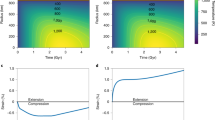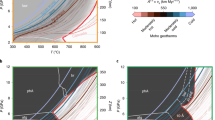Abstract
The tectonics of Europa, one of Jupiter's moons, are complex. This satellite probably hosts a subsurface water ocean, but the thickness of the outer ice crust is poorly constrained and the episodic presence of liquid water at the surface is debated. We argue that some surface features of Europa are formed by soft ice that is heated by viscous dissipation of tidal motion along faults, and do not depend on a shallow ocean. Our model suggests that transient pockets of liquid water or brine could form at shallow depths in the crust.
Similar content being viewed by others
Main
The Galileo spacecraft has returned high-resolution images of surface lineations and ridges on Europa. These have prompted proposals that tidal stresses from Jupiter may fracture the icy crust of the synchronously rotating satellite, allowing material from the interior to reach the surface1,2. One model invokes tidal expansion and contraction of metre-wide cracks which repeatedly force liquid water up from a subsurface ocean to the surface of the moon as it completes each 85-hour orbit3 — a process that depends on a thin (1 km or less) ice shell and which has fuelled speculation that the ocean frequently meets the sunlit surface and could be a habitat for life.
The formation of kilometre-deep cracks in Europa's crust is a problem. Below a depth of 35 m, the pressure from the weight of the overlying ice will exceed the estimated stresses due to tides (<4×104 Pa) and prevent cracks from growing. Any fractures will halt at a depth where warmer, less viscous ice flows, rather than fracturing further, to accommodate tidal strain. Taking an estimated strain rate of 2×10−10 s−1 and a relation between normal stress and yield stress appropriate for ice4, we find that the brittle–ductile transition occurs at depths where temperatures5 exceed 170 K, well above those of any ice–ocean interface.
Also, liquid water in a crack will freeze solid by virtue of the conduction of heat to the walls: the freezing time is t = w2/(16κλ2), where w is the crack width, κ is the thermal diffusivity of ice (1.7×10−6 m2 s−1) and λ is a dimensionless parameter6 equal to about 0.3. A 1-m crack will freeze in 1.3 orbits. Hydrostatic forces are too weak to extrude ice from such a narrow orifice and, unless a compensatory removal of crust occurs elsewhere, the crack will disappear.
We propose, alternatively, that tides drive viscous flow and heating by dissipation at zones of lateral motion (strike–slip) in the crust. There is accumulating evidence for strike–slip motion on Europa7. The relative motion along a fault or defect will produce frictional heating, causing the local temperature to increase and the viscosity of the ice to decrease8. This feedback can lead to accommodation of the relative motion of two blocks of crust by viscous flow in a zone of finite width, rather than a discontinuity at a fault. Steady-state conditions in the zone are derived by equating the production of heat by viscous dissipation with its loss by conduction to the surrounding ice.
Strike–slip motion of amplitude a at a diurnal period t (3×105 s) will maintain a temperature Tc and viscosity ηc at the centre of the shear zone6 that satisfy 16kRTc2 t2=π2ηcEaa2, where Ea and k are the activation energy (6×104 J at 273 K) and thermal conductivity (2.1 W m−1 K−1 at 273 K), respectively, of the ice, and R is the gas constant.
A plausible diurnal motion3 of 0.6 m can maintain the ice in the centre of the shear zone at a temperature of 273 K, where its viscosity will be roughly 1013 Pa s. The width of this zone of soft ice is δ=ηa(τt)−1, where τ is the shear stress (about 1 km for τ=2×104 Pa). This warm ice will have a buoyant density contrast Δρ=20 kg m−3 with respect to the surrounding ice and will flow upwards by a few tens of centimetres over the course of one tidal cycle.
We suggest that such motion over the course of many cycles could be responsible for the formation of structures such as ridge pairs. Our model does require the existence of an ocean (not necessarily shallow): without the mechanical decoupling between the ice crust and the interior, the motion of the crust would be 30–50 times smaller.
Larger strike–slip motion may lead to partial melting (liquid water) in the shear zone. The melt-generation rate scales as τ2(ρηcL)−1, where L and ρ are the latent heat of fusion (3.25×105 J kg−1) and density (900 kg m−3), respectively, of ice. This production will be balanced by downward percolation of the denser melt at a rate9 AφnΔρ g(ηmh)−1, where A and n are constants, φ is the melt fraction, ηm is the melt viscosity, h is the thickness of the melt column, and g (1.3 m s−2) is Europa's surface gravity. Although there are considerable uncertainties in some of these values, the equilibrium melt fraction is of the order of 1%. This much melt will form only if the strike–slip motion is sufficiently large (∼1 m) to compensate for the reduction in ice viscosity by a factor of about one third as a result of the presence of melt10.
The pore pressure due to the presence of melt will also increase the depth to the brittle–ductile transition and allow fractures to accommodate strike–slip motion and to slow heat generation. Melt pockets below the fracture zone will percolate downwards at a velocity of a few tens of metres per year, and so will have a lifetime of ∼1,000 years. Any melt at the base of the fracture zone will escape through the fractures or freeze and, if salts are present, brines will be rejected from the freezing melt11.
In this case, the melt lifetime, estimated by equating the latent heat that must be rejected to the rate of thermal conduction away from the fault zone, will be about 30 years (although shorter at shallow depths, where vertical conduction to the surface is important). Depending on the thickness of the fractured zone, transient liquid-water or brine pockets may exist within reach of sunlight, potentially providing habitats for photosynthetic organisms capable of remaining dormant in ice for millennia12 between relatively brief ‘blooms’.
References
Sullivan, R. et al. Nature 391, 371–373 (1998).
Pappalardo, R. T. et al. J. Geophys. Res. 104, 24015– 24055 (1999).
Greenberg, R. et al. Icarus 135, 64–78 (1998).
Rist, M. A. J. Phys. Chem. B 101, 6263–6266 (1997).
Pappalardo, R. T. et al. Nature 391, 365–367 (1998).
Turcotte, D. L. & Schubert, G. Geodynamics: Applications of Continuum Physics to Geological Problems (Wiley, New York, 1982).
Tufts, B. R. et al. Icarus 141, 53–64 (1999).
Stevenson, D. J. in Europa Ocean Conf., Capistrano Conf. 5 69– 70 (San Juan Capistrano Res. Inst., CA, 1996).
McKenzie, D. Earth Planet. Sci. Lett. 74, 81–91 (1985).
Duval, P. Int. Assoc. Sci. Hydro. 118, 29–33 (1977).
Cottier, F., Eiken, H. & Wadhams, P. J. Geophys. Res. 104, 15850– 15871 (1999).
Vorobyova, E. et al. FEMS Microbiol. Rev. 20, 277– 290 (1997).
Author information
Authors and Affiliations
Rights and permissions
About this article
Cite this article
Gaidos, E., Nimmo, F. Tectonics and water on Europa. Nature 405, 637 (2000). https://doi.org/10.1038/35015170
Issue Date:
DOI: https://doi.org/10.1038/35015170
This article is cited by
-
Planned Geological Investigations of the Europa Clipper Mission
Space Science Reviews (2024)
-
Radar for Europa Assessment and Sounding: Ocean to Near-Surface (REASON)
Space Science Reviews (2024)
-
Double ridge formation over shallow water sills on Jupiter’s moon Europa
Nature Communications (2022)
-
Ice-Ocean Exchange Processes in the Jovian and Saturnian Satellites
Space Science Reviews (2020)
-
Active formation of ‘chaos terrain’ over shallow subsurface water on Europa
Nature (2011)
Comments
By submitting a comment you agree to abide by our Terms and Community Guidelines. If you find something abusive or that does not comply with our terms or guidelines please flag it as inappropriate.



